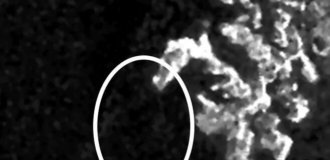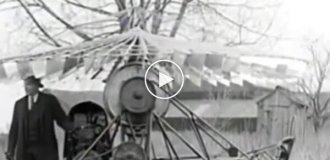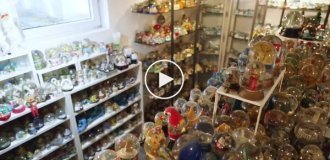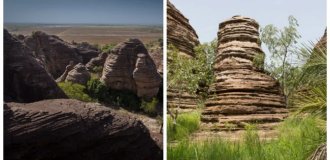Semipalatinsk nuclear test site 20 years later (50 photos)
Not long ago, Kazakhstan celebrated the 20th anniversary of the closure of the Semipalatinsk nuclear test site. Two decades. It seems like a very short period of time, but during this time a whole generation has grown up, which knows about barbaric weapons and their tests only from the stories of their parents. And even more so, it is difficult for this younger generation to understand why a huge part of the territory of their native country is actually lost forever. Meanwhile, the landfill has been living its own life for 20 years now. And as it turns out, the cessation of testing of nuclear and hydrogen explosive devices does not mean at all that destructive processes in the environment have stopped. The phenomenon of Kazakh nuclear science in a special photo report by Grigory Bedenko

1. The main attraction of the former test site is the “atomic” lake, which is located at the Balapan test site. It was formed as a result of the explosion of a thermonuclear warhead with a capacity of 140 kilotons in 1965. The diameter of the lake is 500 meters, the depth from the surface of the water to the bottom is 80 meters In a similar way, Soviet strategists planned to build reservoirs in the arid regions of the Soviet Union.

2. Specialists from IRBE (Institute of Radiation Safety and Ecology of the National Nuclear Center of the Republic of Kazakhstan) say that the charge was “clean”, and therefore the scatter of radioactive isotopes at the facility is minimal. It is curious that the water in the “nuclear” lake is clean, and there are even fish there. However, the edges of the reservoir “fog” so strongly that their level of radiation is actually equivalent to radioactive waste. In this place, the dosimeter shows 1 microsievert per hour, which is 114 times more than normal

3. An interesting fact about the “atomic” lake: the detonation of a thermonuclear device with a capacity of 140 kilotons is equivalent to the simultaneous detonation of 2 thousand cars with TNT

4. During the explosion, soil was thrown out of the crater, and some pieces of neophyte clay flew up a kilometer, and then fell at approximately the same distance from the explosion site. They "sound" very loudly

5. This glassy mass, according to experts, was in close proximity to the thermonuclear charge. Enormous pressure and temperature turned granite into a kind of volcanic pumice

6. Sergey Borisovich Subbotin. At the test site they call him the owner of the “atomic” lake. He is the head of the geographic information technology laboratory, and constantly looks after the facility. By the way, Sergei Borisovich at one time provided geological support for underground testing. He is one of those specialists who directly created the Soviet nuclear shield. Well, one more thing, this handsome man is very similar to Vladimir Vysotsky, even the timbre of his voice is the same

7. Chagan River.
“Very high concentrations of tritium (a radioactive isotope of hydrogen) were discovered there,” says Subbotin. - They reach about 700 kilobeccrels per liter. That is, this is almost 100 times higher than the standard values for drinking water. Pollution continues somewhere within 10 kilometers from the borders of the landfill. And part of the territory that is contaminated with tritium is still planned to be included in the landfill

8. What’s most amazing is that people live next to the lake, about two kilometers away. They raise livestock and drink water from a contaminated river. Local authorities turn a blind eye to this. This woman categorically refused to talk to journalists

9. And this is the farm itself. Apparently there isn't even electricity there.

10. Atomic horses

11. In general, what is most striking at the test site is the vigorous economic activity. Moreover, in the dirtiest places. It is very difficult to imagine something like this anywhere in Nevada, or in the Lop Nor area

12. However, horses are smart. When they eat grass, they tear off only the top part of it, without grabbing the soil with radionuclides. Therefore, kumiss, as they say in IRBE, is clean at the landfill

13. “Tablet” with IRBE scientists rises to the shore of the “atomic” lake. Before the explosion there was an absolutely flat steppe

14. Land subsidence and as a result of an underground nuclear explosion. The so-called “combat well”

15. Such objects need to be observed constantly. As a result of neutron activation of coal seams, some strange processes occur underground. Subbotin said that they had a case where a well exploded 15 years after testing. A column of fire burst out from under the ground, and the ground in this place sank within a radius of 100 meters.

16. A fox skull found near a well turned out to be clean.

17. The owner of the fighting well is a wild dog. I sat and watched the shooting with great curiosity. But when I tried to get closer to him, he began to growl, and then ran away a few meters

18. The former center of the Semipalatinsk nuclear test site - the city of Kurchatov, in 2011, resembles the scenery for a computer game like S.T.A.L.K.E.R. "Call of Pripyat"

19. Here are the most beautiful ruins I have ever seen

20. Until now, half of this amazing settlement resembles a ghost town

21. The ruins are surprisingly alive...

22.

23

24. Our scientists inherited unique nuclear reactors from the military. This is the building of the “research graphite reactor” (IGR). It was designed by Igor Kurchatov himself to identify critical loads for such installations

25. Today, experiments are being carried out at the reactor, the purpose of which is to simulate the behavior of various materials during a severe accident at a nuclear power plant, such as Chernobyl or Fukusism

26. The experiments are carried out on behalf of the Japanese Atomic Energy Agency

27. Head and chief engineer Valery Aleksandrovich Gaidaichuk

28. Specialists are preparing a probe with materials that will be subjected to a powerful neutron flash inside the reactor. What will happen to these materials is the subject of research

29. And this is what the underground structure looks like from the outside, which houses another reactor - IVG-1 M (research high-temperature gas reactor)

30. In a special underground bunker, a corridor almost a kilometer long leads to it

31. The reactor is a prototype nuclear rocket engine. It heats hydrogen to ultra-high temperatures and creates jet thrust. During Khrushchev’s time they wanted to fly to Mars with such an engine

32. “Fuel for a nuclear rocket engine has already been created,” says Alexander Nikolaevich Kolbaenkov, head of the Baikal-1 reactor complex. - It met the parameters that were laid down according to the technical specifications - these are temperature, pressure, service life and specific impulse of 925 seconds. This was all received. And, in principle, if this work had not been stopped, then we would probably have come to testing a serial engine that could be launched into orbit and launched there

33. Kolbaenkov has been working here for almost 40 years

34. Spent nuclear fuel storage facility (SNFS) at the Baikal-1 facility. Here is the fuel from the shutdown Aktau reactor BN-350, which operated at MAEK. The fuel is uranium-235 and plutonium-239..

35. Another “attraction” of the landfill. This is where the first Soviet atomic bomb was detonated in 1949.

36. This ominous structure is called “goose”. Using such reinforced concrete structures, the shock wave of a nuclear explosion was measured

37. Radiation measurement. In this place the temperature and pressure were so enormous that the concrete “flowed”, absorbing radionuclides

38. The first Soviet atomic bombs were “dirty”, so everything on the “experimental field” was contaminated with plutonium. You can only walk in a respirator

39. These buildings contained measuring equipment

40. IRBE specialists live in these modules on the “experimental field”. Why is living here dangerous? The fact is that this facility is the beginning of the Soviet military nuclear program. There are many different sites at the training ground, but it all started with the “experimental field”. The first Soviet nuclear and hydrogen explosive devices were very dirty. Only 30-40% of the charge mass worked in them. The rest of the charge, which was mainly plutonium, an extremely dangerous isotope for all living things, was sprayed into the environment. Thus, the “experimental field” is almost completely infected with it. An area of 300 square kilometers is considered lost - the half-life of plutonium-239 is about 20 thousand years. A person can inhale plutonium nanoparticles along with dust if he walks through contaminated “spots” or if the wind rises. It is impossible to remove plutonium from the body - even if one particle gets inside, it will simply burn out all the tissues around it. Therefore, IRBE specialists who live in the “experimental field” are at great risk to their health. This is a kind of feat in the name of science. Without exaggeration

41. An experimental livestock farm operates here

42. A brave man, Symbat Baygaziev, a specialist at the institute, looks after the animals

43. Symbat and his ward – mare Anka

44. The experiment is as follows: some animals are fed contaminated food, others are given contaminated water. Still others graze in contaminated areas. The purpose of the experiment is to determine what radiation dose the local population receives by eating “dirty” food products.

45. Symbat and the calf Buyan. 200 meters from this place is a plutonium crater from a hydrogen bomb

46. The brainchild of Kazakhstan's independence - TOKAMAK - a prototype of the thermonuclear reactor of the future. Designed to study the properties of materials

47. Gennady Shapovalov - researcher at the Institute of Atomic Energy and chief at TOKAMAK.
- In general, a fairly wide range of research is planned on this TOKAMAK. This is a new installation, which has its own specific physical parameters, which are not available on similar installations in the world.

48. Molten concrete on the “experimental field”.

49. Today we can safely say that the development in our country of sciences related to atomic energy is a completely unprecedented and even paradoxical fact in the Eurasian space. Everything should have happened exactly the opposite: when the last military man left the test site near Semipalatinsk, the city of Kurchatov was supposed to share the fate of numerous post-Soviet ghost towns. And what would seem simpler is to wrap the contaminated areas with barbed wire and forget about them forever. But the reality is actually much more complicated - the consequences of nuclear weapons tests were, remain and will remain a part of our lives






















